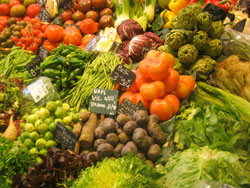Fuel Your Body for Performance in the “Sport of Life”
 You’ve already downloaded the Weekly Nutrition Tracking Sheet and have a couple of weeks of information to review. Understanding what you are putting in your body is the first step in making positive changes.
You’ve already downloaded the Weekly Nutrition Tracking Sheet and have a couple of weeks of information to review. Understanding what you are putting in your body is the first step in making positive changes.
Today we are going to review the basics of nutrition. Some of it may be new to you, other details you may have heard before. Regardless, if you aren’t CONSISTENTLY doing the things I will mention below, you are needlessly struggling with a completely controllable situation. In other words, if you aren’t regularly doing these things and you are unhappy with your current body fat levels, it’s time to finally make some changes.
The first thing that you need to know about nutrition is this fact. Everyone is different and will require different types and proportions of food (carbohydrates, fats, and protein). This is determined by your Metabolic Type. Essentially your metabolic type tells us how your body deals with and processes certain types of food.
Carbohydrate types are called “slow oxidizers” because their bodies are slower to metabolize (break down) food molecules. Because of this, they do better eating less complex molecules such as carbohydrates. This doesn’t mean they should avoid fats and protein, just that they need less of them to function optimally.
Protein types are the opposite. They are “fast oxidizers” and do well with a higher percentage of fat and protein because their bodies are able to more rapidly break these more complex molecules down into digestible components.
Mixed types are somewhere in the middle between these two ends of the metabolic typing spectrum and share components of both carbohydrate and protein types.
To Find out YOUR Metabolic Type, click the link to your left. While there is a huge amount of information needed to fully understand your body’s response to food and how it fits with your metabolic type, the answers to this questionnaire will at least get you thinking about your individual responses and attitudes to food (VERY IMPORTANT). Plus it will give you the basics of getting started.
OK, outside of the Metabolic Typing side of things, here are a few general guidelines that will ensure you get the best results in the shortest amount of time…
Eat on a steady schedule
-
- Eating small meals every 3-4 hours will increase your metabolism and reduce fat storage. This is a proven fact that bodybuilders, models, athletes and lean people, in general, abide by – and so should you.
- If you have trouble remembering, write it down or set a reminder in your computer or handheld device. Plan ahead to make sure you have food ready when the reminder goes off. You will be amazed at how much time, frustration and suffering this simple planning action will save you in the long run!
Plan your daily nutrition like an “inverted pyramid”
-
-
- Breakfast is by far the most important meal of the day! Eating right when you wake up is vital to breaking the fast your body enters every night (hence the name “breakfast”)!
- About 3-4 hours after you eat, your body begins shutting down your metabolism and acts as if it needs to store food. This is a great function to have if a famine breaks out and you don’t see food for weeks. After all, if there’s famine you’re going to want your body to work “efficiently” by storing fat, and using it slowly.
- However, I’m sure you don’t want your body to store fat and burn it slowly. Since there is no food shortage or famine at the moment (and there likely won’t be one anytime soon) then it is pretty annoying when your body starts packing on the pounds. So, in order to communicate with your body by sending signals that it is healthy, well fed, and not in need of extra fat storage, you need to reprogram your metabolism.
- You also need your energy most during the day. That’s why breakfast (or at least lunch) should be your largest meal. Now when I say “large” I’m not talking buffet “pig-out”, but a properly sized portion to meet your needs. (see the next point).
- From this point on in the day, your meals should slightly decrease in portion size based on your energy needs. For most people their largest meal is dinner. They’ve just taken in the majority of their daily calories and then promptly go to bed. The metabolism slows down during sleep and your body doesn’t need a lot of energy. Therefore most of the calories you just consumed are stored as body fat.
-
Understand proper portion sizing for YOUR nutritional needs
-
- One of the best tricks for learning proper portion sizes without having to weigh and measure food forever is to eat food on smaller plates. Most people have such a skewed perception of proper portion size that they are in disbelief when actually shown. For example, the majority of people should be able to EASILY fit a full meal on a typical side plate. Even me, as a young, active, fit person have my meals fit on side plates!
- With this being said, it’s still important to gain an understanding of the portion sizes and calorie totals of the typical foods you eat. You don’t have to do this forever because once you get used to it, you will be able to “eyeball” the amounts and be confident in your portioning decision.
Choose quality EVERY TIME!
-
- First, high-quality food just tastes better.
- Second, you will be getting more nutrients in less volume. Because of this, your body will not feel the need to keep eating (remember, the underlying need for eating is to receive nutritional value so that we can survive)! High-quality foods do this MUCH more effectively than the cheap CRAP most people pass off as food.
- Even things that are seemingly “bad” for you such as treats should conform to this rule. If you are going to have a dessert or treat such as a glass of wine, at least have a top quality one! As the saying goes…life’s too short to be drinking bad wine (or chocolate)!
Be strict with yourself at the beginning, but still enjoy life!
-
- Let’s face it, you are overweight and out of shape because what you’ve been doing up to now hasn’t been conducive to optimal body composition and health. Therefore, you need to make changes. This requires doing something DIFFERENT than you are used to!
- In the beginning, you may not enjoy these changes. In fact, you may struggle to make them. That’s OK. Like many things in life, change takes time. With consistency, a realistic perspective, and a dedication to reach your goals, these changes will become the norm in your life and you will be able to set your sights on future improvements.
- Just remember that making changes doesn’t mean suffering and being miserable. To make the changes stick, you will have to be strict with yourself and stick to the plan. However, a well-designed plan will have some leeway, and incorporate FUN and enjoyment into the schedule. Without this, the plan will rarely be sustainable over the long-term and the chance of relapse to old habits is very high.
To learn more about Metabolic Typing and find out how you can have one of our Holistic Lifestyle Coaches guide you through the challenges of learning about and understanding how to eat right for your metabolism in any situation, just send us an email with more questions.

